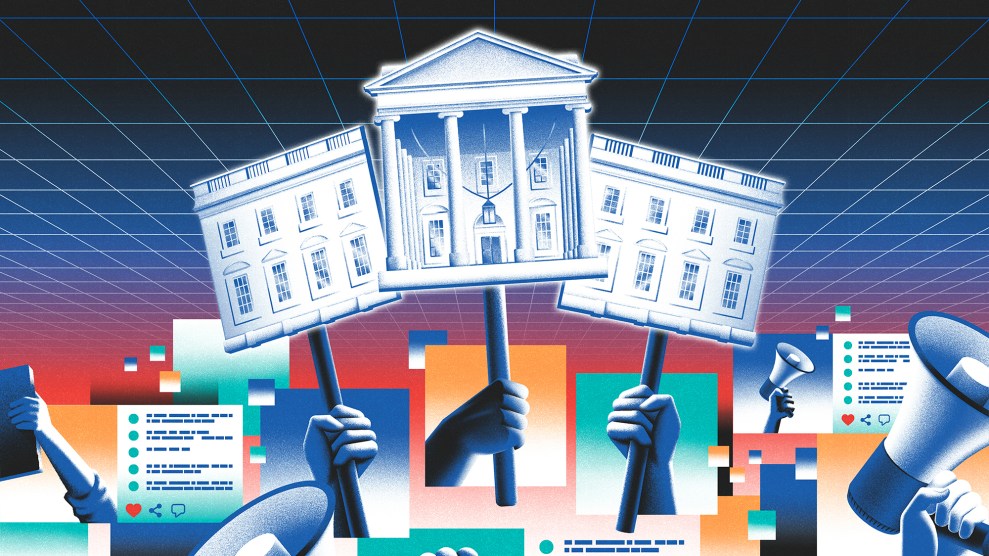After her novel The God of Small Things sold 6 million copies, how easy it would have been for Arundhati Roy to retreat from the world and sit quietly at her desk. Instead, Roy has used her literary perch to become a leading critic of World Bank-style development and the injustices of globalization. In her latest book, Power Politics, Roy describes her struggle to halt the Sardar Sarovar dam, which will displace 500,000 people in India’s Narmada Valley. Of her many controversial stands, this one has brought Roy the most trouble: Her unwillingness to hold her tongue following the Indian Supreme Court decision that the building of the dam should proceed brought her a contempt-of-court charge, for which she will go on trial in January.
In the aftermath of September 11, the 40-year-old Roy also voiced her strident opposition to the bombing of Afghanistan–“It’s like burning the haystack to find the needle”–in op-ed pages thoughout the English-speaking world. For straying from fiction, Roy has been labeled a “writer-activist,” a tag she resists. “I’ve been saddled with this double-barreled appellation,” she writes, because “I have a point of view. What’s worse…I use everything in my power to flagrantly solicit support for that position. Now, for a writer of the 21st century, that’s considered a pretty uncool, unsophisticated thing to do.” When Roy spoke to Mother Jones from her home in New Delhi, she made it clear she believes it’s time to stand up and take sides.
Mother Jones: I don’t think many Americans are aware of the human costs of dam building in India. How many have been uprooted?
Arundhati Roy: What’s so shocking is that we don’t even have an estimate of how many people have been displaced. We know there were 3,300 big dams built in India in the last 50 years. Let’s assume that each dam displaced an average of 10,000 people, which is ridiculous; the Sardar Sarovar is itself displacing half a million people. But even using the 10,000 figure, you get 33 million people. And you have a government who doesn’t have a rehabilitation policy at all. Of course, in the case of Sardar Sarovar, the Supreme Court allows this dam to proceed even though the government of Madhya Pradesh, where 80 percent of the displaced people live, has a written affidavit saying, “We have no land to resettle these people.”
MJ: Do you think the court is corrupt?
AR: I’m being hauled up for criminal contempt of court, facing a jail sentence for whatever I’ve had to say. So I can’t tell the whole truth.
MJ: I won’t get you in trouble, but that’s– AR: It’s unbelievable. Gradually, this incredible 15-year-old nonviolent movement is coming apart. The movement in the Narmada Valley and so many other resistance movements in India are precious because they are nonviolent movements. They are reasonable, totally beautiful things. [But the government] just kicks them aside, has no time for them.
MJ: So the movement is fading?
AR: It’s winding down because people don’t know what to do. Unless they decide to become militant, what are they going to do? This is what I keep saying: If you are against violence, then surely you must have some space for nonviolent protest, for reasonable protest. If you block off that, what are people supposed to do? When they pick up a gun, then you’re going to pay them some attention. You will see that you’re actually promoting violence.
MJ: By not recognizing the justice of the cause, or even listening to the people?
AR: You just put the lid on something like this in a totally unreasonable way. And you know, you have the huge poverty of India around you, the slums in the city. Who are these people? They’re the 33 million that have been displaced. Then the government wants to bulldoze their slums; they want to close down what they call “polluting units.” In Delhi, that’s what they did last year.
MJ: Their villages were flooded, so they come to the city and then–
AR: They’re shut down. Their houses are bulldozed. It’s like you’re gradually stealing the air they breathe. People are so, so angry, but they’re so helpless. It isn’t as though the government picks up a gun and mows them down. It just shuts off the oxygen supply.
MJ: In Power Politics you write about how governments misdirect their people’s legitimate anger into fights over religion.
AR: You bring a society to its knees, and then the only thing that makes sense to people is some kind of religious fervor. Like in Afghanistan and Pakistan. In India, it’s Hindu, but it’s the same thing.
MJ: But do you think leaders are really so cynical as to say, “I’m going to do something that will lead to turmoil, and then I’ll redirect that rage in a religious direction”?
AR: Yes. I absolutely think so. I think all governments do that. I think the American government does that now in America. How is it possible for somebody to be talking about “good and evil” and “We will rid the world of evildoers”? You know that the people who are saying these things are the people who are involved in the weapons industry, who are involved in the oil industry. They know how these things are done. However naive they sound, it is not possible to believe they are naive.
MJ: Do you feel American policy led in some way to the events of September 11?
AR: Because America is such a powerful country, its mistakes are seriously powerful mistakes. I don’t think I’ve spoken to a single person–whether it’s a person selling tomatoes in the market or it’s a senior government official–who hasn’t had the same reaction to September 11: “The attack was waiting to happen.” That’s because there’s a huge subterranean reservoir of anger. These people, like Osama bin Laden, or the right-wing Hindu fundamentalists, act as booster pumps that tap into this anger and they pull it up and they mold it to what suits them. But the point is that the anger is there and it is vulnerable to being molded any crazy way. If you’re not going to address the anger, you can get rid of the booster pump, but another one will only take its place.
MJ: Then how do you prevent terrorism?
AR: The world has not yet found an acceptable definition of what terrorism is. One country’s terrorist is too often another country’s freedom fighter. The U.S. government has funded, armed, and sheltered plenty of insurgents and terrorists around the world. Today, Pakistan sponsors insurgents who cross the borders into Kashmir and India. Pakistan calls them freedom fighters. India calls them terrorists. India denounces terrorism, but the Indian army trained separatist rebels in Sri Lanka, the ltte. And just as the CIA abandoned the mujahedin after they’d served its purpose, India abruptly turned its back on the ltte. It was an enraged ltte suicide bomber who assassinated former Prime Minister Rajiv Gandhi. At the heart of the matter lies the world’s deep-seated ambivalence toward violence. If violence is accepted as a legitimate political instrument, then the morality and acceptability of terrorists becomes bumpy terrain.
MJ: So what is to be done?
AR: There are two things that have to be done. One is that this bombing has to stop. It has to stop now. These missiles are blowing up warehouses of fury. Eventually [by bombing Afghanistan] you are endangering your own people. The second is that information has to get out to the mainstream, non-Internet-using middle-class America. One thing I do admire about America is that once Americans have the information they need, and see the problem they face, they are capable of the most spectacular forms of protest.
MJ: There’s been some backlash to your antiwar stance. What do you make of that?
AR: There’s no point in reacting to critics as if they are anti-American or old communists or Islamic fundamentalists. We aren’t that. I’m not a communist or a fundamentalist. I’m just a person who doesn’t want the world to go crazy.













